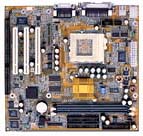Gigabyte GA-6WMM7 i810 Socket-370 microATX
by Mike Andrawes on July 21, 1999 12:28 AM EST- Posted in
- Motherboards
After just a few reviews, Gigabyte has quickly become known as a manufacturer of extremely stable motherboards around here at AnandTech. Their boards always seem to come out as very solid, stable solutions that get the job done without many faults. But what happens when Gigabyte is presented with Intel's i810, a chipset intended for the most cost conscious of markets? Did they make any quality or feature sacrifices in the name of cost? The first i810 AnandTech has looked at from Gigabyte, the GA-6WMM7, shows Gigabyte's strong commitment to what got them where they are.
New Anand Tech Report Card Rating 87/B+
| CPU Interface | Socket-370 |
| Chipset | Intel i810 |
| L2 Cache | N/A (on-chip) |
| Form Factor | microATX |
| Bus Speeds | 66 / 70 / 75 / 83 / 90 /
95 100 / 101 / 105 / 115 / 120 124 / 133 / 140 / 150 |
| Clock Multipliers | 2.0x - 8.0x |
| Voltages Supported | Auto Detect |
| Memory Slots | 2 168pin DIMM Slots |
| Expansion Slots |
1 AMR Slot |
| BIOS | Award 6.00PG |
The Good
The GA-6WMM7 isn't quite your typical i810 board with quite a few features that stray from the normal, barren boards based on this chipset. The first thing that you'll notice is that Gigabyte actually included an ISA slot - quite a rarity in this new market segment. The other biggie is the inclusion of true hardware based sound based on the Yamaha YMF744 PCI chip - most i810's only have software powered AC97 codec's. The addition of true sound adds to the price, of course, something that is quite critical for the target market. Gigabyte realized this as well and the onboard hardware audio is optional with AC97 software sound available in its place.
The 3/1/1/0 (PCI/AMR/ISA/AGP) slot configuration is about as good as it gets in the microATX i810 world. All slots can handle a full length board if necessary. Two DIMM slots, the maximum for an i810 board, round out the expansion options. Intel's 801AA I/O Controller Hub (ICH) was selected by Gigabyte for the GA-6WMM7 and provides full Ultra DMA/66 support. Another version of the board, the GA-6WMMC7 is available with the Intel's ICH0 which only supports UDMA/33 and no hardware audio. Gigabyte also selected the 810-DC100 Graphics and Memory Controller Hub (GMCH) with 4MB 100MHz display cache on the board itself to complete the "high end" version of the i810 on the GA-6WMM7. Two 2MB 7ns SDRAM chips from Goldstar provide the display cache that handles z-buffering for the integrated i752 found on the i810. Interestingly, the GMCH is not topped by a heatsink at all. It did not get hot in AnandTech's testing, however.
Eight 1200uF and four 330uF capacitors surround the CPU socket and provide for excellent stability in overclocked and non-overclocked situations as we've come to expect from Gigabyte. It's nice to see a company up hold their standards of quality in the face of such a cost conscious market that the i810 lives in. Performance was typical for an i810 motherboard - just like the i440BX motherboards out there, all i810 solutions seem to perform within a few percentage points of each other.
The GA-6WMM7 provides for some decent overclocking options, although it can be a bit confusing if you're new to the i810. Fortunately, the Gigabyte manual outlines some of the pitfalls in their section on bus speeds. The default setting is for Auto detection of either 66 or 100MHz based on the state of BSEL (commonly known as B21 on Slot-1 CPU's). A single jumper can be used to force either 66 or 100 MHz operation, but four additional jumpers are required for bus speeds not officially supported by Intel on the i810. These include 66 / 70 / 75 / 83 / 90 / 95 / 100 / 101 / 105 / 115 / 120 / 124 / 133 / 140 / 150. The interesting twist on the i810 is the manner in which the memory speed is derived from the bus speed - Intel intended the memory to run at 100MHz regardless of the bus speed by using a 1:1 ratio when the bus is at 100MHz and a 3:2 ratio when the bus is at 66 MHz. So when overclocking using 70 / 75 / 83 MHz, you end up using the 3:2 ratio and get a memory speed of 105 / 112 / 125, which not all PC100 memory can handle. Speeds above that drop back to the 1:1 ratio. AnandTech's testbed Celeron 366 which normally overclocks just fine to 83 x 5.5 = 458 required CAS 2 memory to even POST at this speed on the GA-6WMM7 and could not boot into Windows. However, the same CPU was completely stable at 90 x 5.5 = 495 using CAS 3 memory.











0 Comments
View All Comments